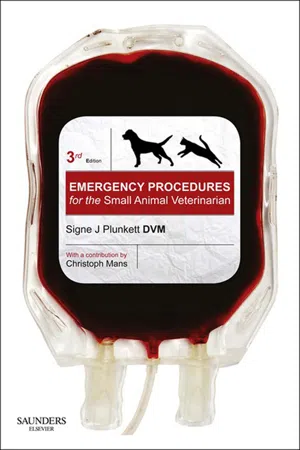
- 688 pages
- English
- ePUB (mobile friendly)
- Available on iOS & Android
Emergency Procedures for the Small Animal Veterinarian E-Book
About this book
The new edition of the hugely successful Emergency Procedures for the Small Animal Veterinarian gives you all the information you need to form a diagnosis quick and accurately, establish a prognosis and recommend treatment for a patient suffering and illness, injury or toxic event.Easy-to-read bullet-point text gives quick access to the most essential information needed to treat emergency cases quickly and efficiently. Loads of practical appendices of commonly used drugs and supplements, drugs in special circumstances (e.g. safe drugs in pregnancy, drugs to avoid in renal failure, etc.), clinical chemistry and laboratory data, conversion tables, and many more, are included for easy reference to essential data.With step-by-step coverage of cardiopulmonary emergencies, trauma gastrointestinal emergencies, toxicological events, a greatly expanded chapter on exotic pets, and much more, Emergency Procedures for the Small Animal Veterinarian gives you the facts you need to help you save more lives faster!
- All you need to know to manage every small animal emergency case you will encounter
- Many excellent and practical appendices of drugs, poisons, lab data, haematology
- Takes the diagnosis-prognosis-treatment approach to every emergency situation
- Easy-to-access format, with concise text and lots of lists
- Divided into organ systems, making it easy to locate information in a hurry
- Handy information on what to tell the owner in emergency injury situations
- Expanded chapter on Emergencies in Exotic Species
- Text updated throughout
- Information on drugs is updated
- New cover design to make the new edition stand out
- Flexicover to protect the book against heavy usage - this is not a book that will remain on the shelves
Frequently asked questions
- Essential is ideal for learners and professionals who enjoy exploring a wide range of subjects. Access the Essential Library with 800,000+ trusted titles and best-sellers across business, personal growth, and the humanities. Includes unlimited reading time and Standard Read Aloud voice.
- Complete: Perfect for advanced learners and researchers needing full, unrestricted access. Unlock 1.4M+ books across hundreds of subjects, including academic and specialized titles. The Complete Plan also includes advanced features like Premium Read Aloud and Research Assistant.
Please note we cannot support devices running on iOS 13 and Android 7 or earlier. Learn more about using the app.
Information
Supportive therapy
Acid–base disturbances

| Dog | Cat | |
| pH | 7.41 (7.35–7.46) | 7.39 (7.31–7.46) |
 | 37 (31–43) | 31 (25–37) |
| [HCO3−] (mEq/L) | 22 (19–26) | 18 (14–22) |
 | 92 (81–103) | 107 (95–118) |
| Disorder | pH |  | [HCO3−] |
| Respiratory acidosis | ↓ | ↑ | ↑ or normal |
| Respiratory alkalosis | ↑ | ↓ | ↓ or normal |
| Nonrespiratory (Metabolic) acidosis | ↓ | ↓ | ↓ |
| Nonrespiratory (Metabolic) alkalosis | ↑ | ↑ | ↑ |
| Clinical guide for compensation | |||
| Disturbance | Primary change | Dogs | Cats† |
| Metabolic acidosis | Each 1 mEq/L ↓ HCO3− |  |  |
| Metabolic alkalosis | Each 1 mEq/L ↑ HCO3− |  |  |
| Respiratory acidosis | |||
| Acute | Each 1 mm Hg ↑  | HCO3− ↑ by 0.15 mEq/L | HCO3− ↑ by 0.15 mEq/L |
| Chronic | Each 1 mm Hg ↑  | HCO3− ↑ by 0.35 mEq/L | Unknown |
| Long-standing‡ | Each 1 mm Hg ↑  | HCO3− ↑ by 0.55 mEq/L | Unknown |
| Respiratory alkalosis | |||
| Acute | Each 1 mm Hg ↓  | HCO3− ↓ by 0.25 mEq/L | HCO3− ↓ by 0.25 mEq/L |
| Chronic | Each 1 mm Hg ↓  | HCO3− ↓ by 0.55 mEq/L | Similar to dogs§ |
Respiratory acidosis




Table of contents
- Cover image
- Title Page
- Table of Contents
- Dedication
- Copyright
- Preface
- Acknowledgments
- List of contributors
- 1 Supportive therapy
- 2 Shock
- 3 Cardiovascular emergencies
- 4 Respiratory emergencies
- 5 Traumatic emergencies
- 6 Environmental emergencies
- 7 Dermatologic emergencies
- 8 Hematologic emergencies
- 9 Gastrointestinal emergencies
- 10 Metabolic and endocrine emergencies
- 11 Urinary emergencies and electrolyte disorders
- 12 Reproductive emergencies
- 13 Neurologic and ocular emergencies
- 14 Toxicologic emergencies
- 15 Emergencies in exotic species
- Appendices
- Index

